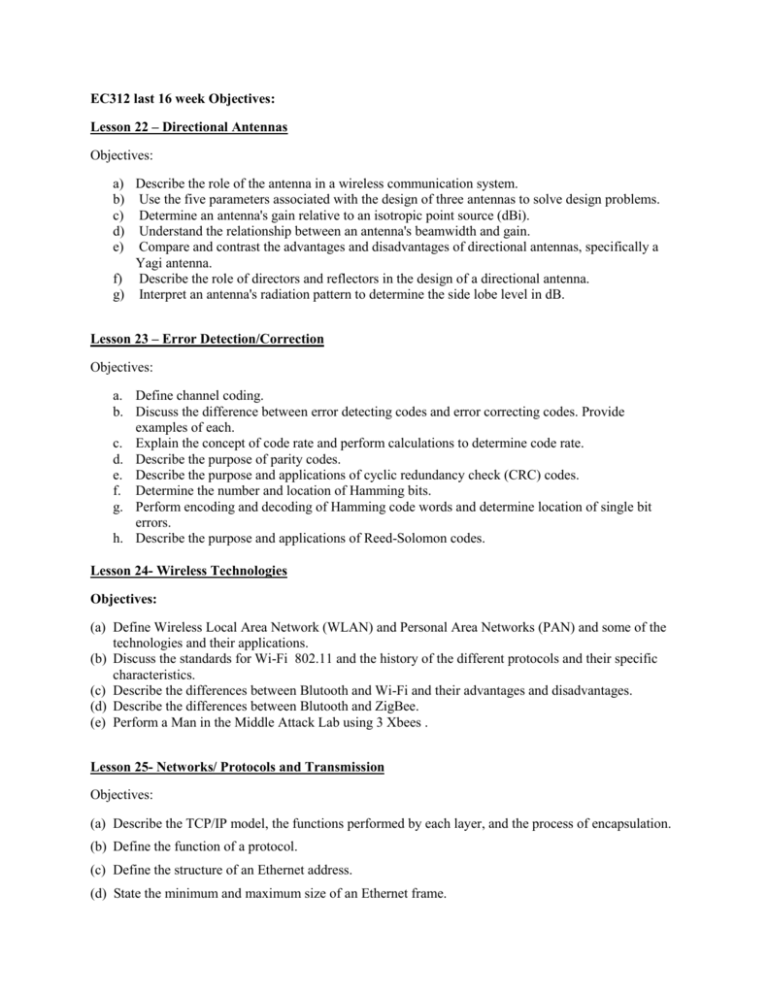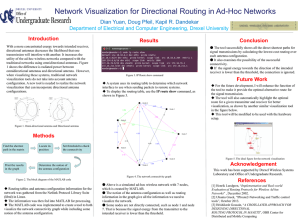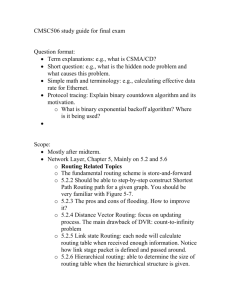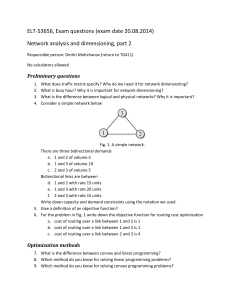EC312 last 16 week Objectives: Lesson 22 – Directional Antennas
advertisement

EC312 last 16 week Objectives: Lesson 22 – Directional Antennas Objectives: a) Describe the role of the antenna in a wireless communication system. b) Use the five parameters associated with the design of three antennas to solve design problems. c) Determine an antenna's gain relative to an isotropic point source (dBi). d) Understand the relationship between an antenna's beamwidth and gain. e) Compare and contrast the advantages and disadvantages of directional antennas, specifically a Yagi antenna. f) Describe the role of directors and reflectors in the design of a directional antenna. g) Interpret an antenna's radiation pattern to determine the side lobe level in dB. Lesson 23 – Error Detection/Correction Objectives: a. Define channel coding. b. Discuss the difference between error detecting codes and error correcting codes. Provide examples of each. c. Explain the concept of code rate and perform calculations to determine code rate. d. Describe the purpose of parity codes. e. Describe the purpose and applications of cyclic redundancy check (CRC) codes. f. Determine the number and location of Hamming bits. g. Perform encoding and decoding of Hamming code words and determine location of single bit errors. h. Describe the purpose and applications of Reed-Solomon codes. Lesson 24- Wireless Technologies Objectives: (a) Define Wireless Local Area Network (WLAN) and Personal Area Networks (PAN) and some of the technologies and their applications. (b) Discuss the standards for Wi-Fi 802.11 and the history of the different protocols and their specific characteristics. (c) Describe the differences between Blutooth and Wi-Fi and their advantages and disadvantages. (d) Describe the differences between Blutooth and ZigBee. (e) Perform a Man in the Middle Attack Lab using 3 Xbees . Lesson 25- Networks/ Protocols and Transmission Objectives: (a) Describe the TCP/IP model, the functions performed by each layer, and the process of encapsulation. (b) Define the function of a protocol. (c) Define the structure of an Ethernet address. (d) State the minimum and maximum size of an Ethernet frame. (e) Calculate the bandwidth available to users in various network configurations. (f) Distinguish between the capabilities and uses of a hub, a bridge and a switch. Lesson 26 – Internet Protocol Objectives: (a) Summarize the principles behind the design of the Internet Protocol. (b) Define the structure of an IP address and define the purpose of network masking. (c) Determine the address space available given an IP address and mask. (d) Identify and explain the basic fields of the IP header. (e) Understand the current use of the IP address space. Lesson 27- Routing Part I Objectives: State the purpose of the Address Resolution Protocol and describe its role in facilitating communication. (b) Describe the mechanism for spoofing an ARP cache with misinformation. (c) Describe how routing works at the network layer. (d) Construct an optimal routing table for a router given a network diagram and using address aggregation. (e) Describe how to make a routing decision based on the longest mask matching principle given a network diagram and a destination IP address. Lesson 28- Routing Part II Objectives: (a) Describe the fundamental algorithms used to construct routing tables. (b) Describe how a routing table is developed using link state routing. (c) Describe how a routing table is developed using distance vector routing. (d) Identify the relative advantages and disadvantages of link state routing and distance vector routing. Lesson 29- Man in the Middle Attack Objectives: (a) Describe the Man-In-The-Middle (MITM) attack and list what advantages it provides the attacker. (b) Construct a routing table based on a network diagram and manipulate a routing table to exploit a specific target. (c) Describe the steps that should be taken to prevent false route injection and identify who is responsible for performing these preventative actions and how they can be applied.






![Internetworking Technologies [Opens in New Window]](http://s3.studylib.net/store/data/007474950_1-04ba8ede092e0c026d6f82bb0c5b9cb6-300x300.png)


